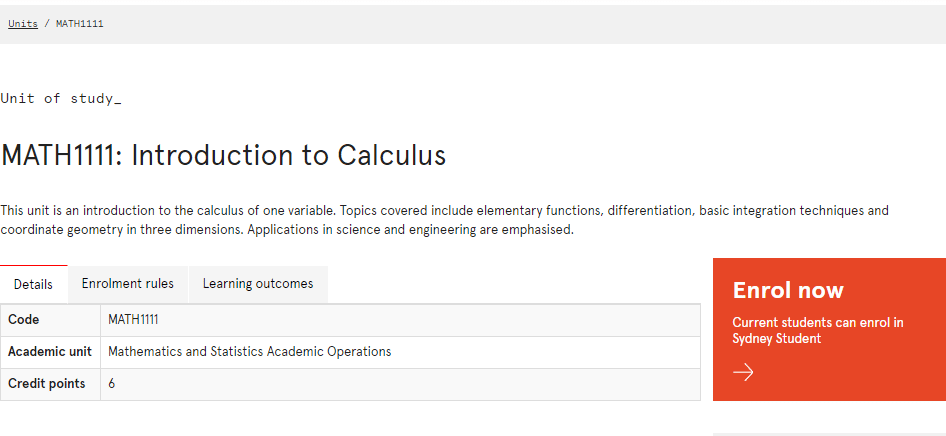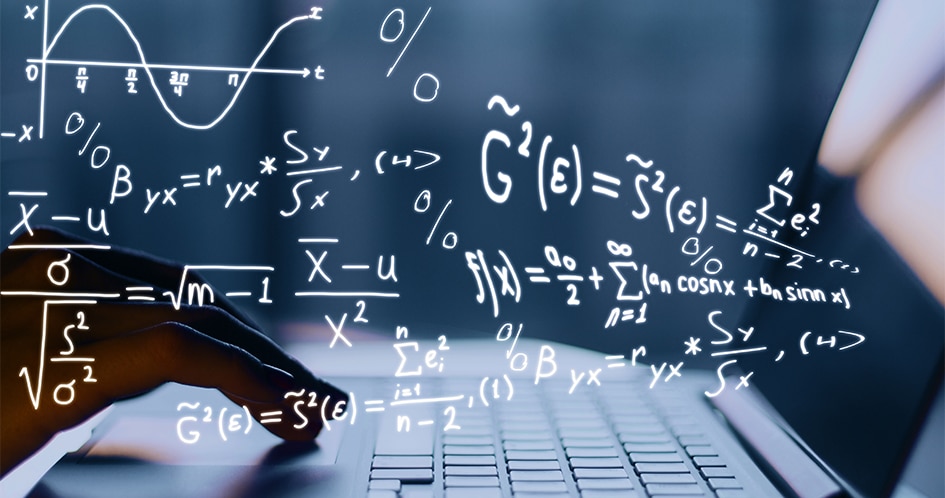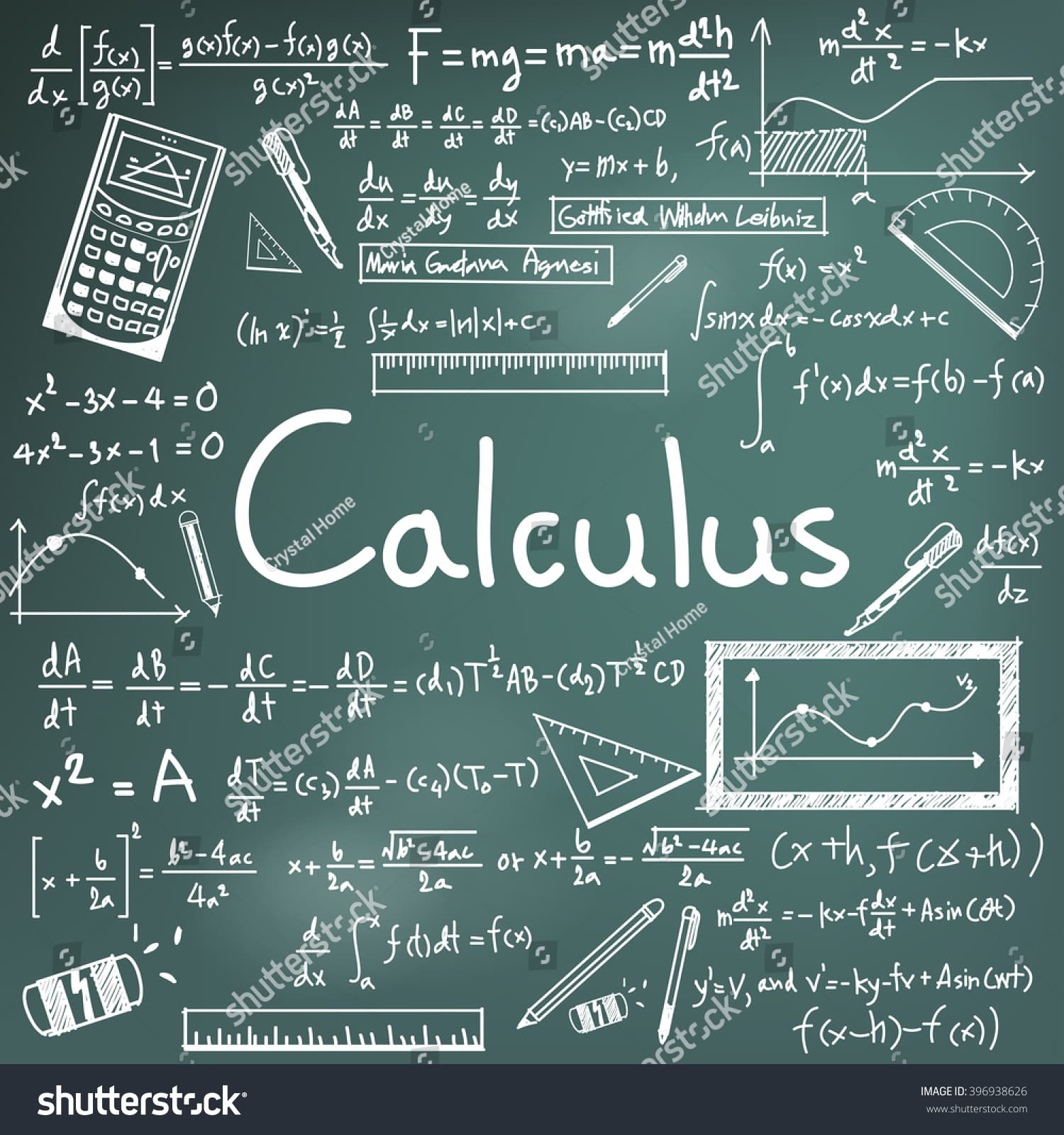MY-ASSIGNMENTEXPERT™可以为您提供sydney MATH1111 Calculus微积分的代写代考和辅导服务!
这是悉尼大学 微积分课程的代写成功案例。

MATH1111课程简介
This unit is an introduction to the calculus of one variable. Topics covered include elementary functions, differentiation, basic integration techniques and coordinate geometry in three dimensions. Applications in science and engineering are emphasised.
Prerequisites
At the completion of this unit, you should be able to:
- LO1. Apply mathematical logic and rigour to solving problems, and express mathematical ideas coherently in written and oral form;
- LO2. Demonstrate fluency in manipulating real numbers, their symbolic representations, operations, and solve associated algebraic equations and inequalities;
- LO3. Develop fluency with lines, coordinate geometry in two dimensions, the notion of a function, its natural domain, range and graph;
- LO4. Become conversant with elementary functions, including trigonometric, exponential, logarithmic and hyperbolic functions and be able to apply them to real phenomena and to yield solutions of associated equations;
- LO5. Perform operations on functions and be able to invert functions where appropriate;
- LO6. Understand the definitions of a derivative, definite and indefinite integral and be able to apply the definitions to elementary functions;
- LO7. Develop fluency in rules of differentiation, such as the product, quotient and chain rules, and use them to differentiate complicated functions;
- LO8. Understand and apply the Fundamental Theorem of Calculus; and develop fluency in techniques of integration, such as integration by substitution, the method of partial fractions and integration by parts;
- LO9. Develop some fluency with coordinate geometry in three dimensions, planes, surfaces, ellipsoids, paraboloids, level curves and qualitative features such as peaks, troughs and saddle points.
MATH1111 Calculus HELP(EXAM HELP, ONLINE TUTOR)
Find the intervals on which $f$ is increasing/decreasing and the intervals on which $f$ is concave up/down. Use this information to sketch the graph of $f$.
$$
f(x)=\frac{x}{x^2+1} .
$$
To say that $f(x)$ is increasing is to say that $f^{\prime}(x)>0$. Let us then compute
$$
f^{\prime}(x)=\frac{x^2+1-2 x \cdot x}{\left(x^2+1\right)^2}=\frac{1-x^2}{\left(x^2+1\right)^2} .
$$
Since the denominator is always positive, $f(x)$ is increasing if and only if
$$
1-x^2>0 \quad \Longleftrightarrow \quad x^2<1 \quad \Longleftrightarrow \quad-10$. In this case, we have
$$
\begin{aligned}
f^{\prime \prime}(x) & =\frac{-2 x\left(x^2+1\right)^2-2\left(x^2+1\right) \cdot 2 x\left(1-x^2\right)}{\left(x^2+1\right)^4} \
& =\frac{-2 x\left(x^2+1\right)-4 x\left(1-x^2\right)}{\left(x^2+1\right)^3}=-\frac{2 x\left(x^2+1+2-2 x^2\right)}{\left(x^2+1\right)^3} \
& =-\frac{2 x\left(3-x^2\right)}{\left(x^2+1\right)^3}=\frac{2 x(x-\sqrt{3})(x+\sqrt{3})}{\left(x^2+1\right)^3} .
\end{aligned}
$$
To determine the sign of this expression, one needs to find the sign of each of the factors. According to the table below, $f(x)$ is concave up if and only if $x \in(-\sqrt{3}, 0) \cup(\sqrt{3},+\infty)$.
Show that the cubic polynomial $f(x)=x^3+a x^2+b x+c$ has a unique real root for any given constants $a, b, c$ such that $a^2<3 b$.
Since $f$ is a polynomial, it is certainly continuous and we also have
$$
\lim {x \rightarrow-\infty} f(x)=\lim {x \rightarrow-\infty} x^3=-\infty, \quad \lim {x \rightarrow+\infty} f(x)=\lim {x \rightarrow+\infty} x^3=+\infty .
$$
In view of the intermediate value theorem, $f$ must then attain all values, so it must have a real root. Suppose that $f$ has two roots $x_1<x_2$. Then $f^{\prime}$ must have a root in $\left(x_1, x_2\right)$ by Rolle’s theorem. On the other hand, it is easy to check that
$$
f^{\prime}(x)=3 x^2+2 a x+b
$$
is a quadratic whose discriminant $\Delta=(2 a)^2-4 \cdot 3 b=4\left(a^2-3 b\right)$ is negative. Thus, $f^{\prime}$ does not have any real roots and this means that $f$ has a unique real root.
Find the global minimum and the global maximum values that are attained by
$$
f(x)=4 x^3+x^2-2 x-1, \quad 0 \leq x \leq 1 .
$$
The derivative of the given function can be expressed in the form
$$
f^{\prime}(x)=12 x^2+2 x-2=2\left(6 x^2+x-1\right)=2(3 x-1)(2 x+1) .
$$
Thus, the only points at which the minimum/maximum value may occur are the points
$$
x=0, \quad x=1, \quad x=1 / 3, \quad x=-1 / 2 .
$$
We exclude the rightmost point, as it does not lie in the given interval, and we compute
$$
f(0)=-1, \quad f(1)=4+1-2-1=2, \quad f(1 / 3)=\frac{4}{27}+\frac{1}{9}-\frac{2}{3}-1=-\frac{38}{27} .
$$
This means that the minimum is $f(1 / 3)=-38 / 27$ and the maximum is $f(1)=2$.
Find the linear approximation to the function $f$ at the point $x_0$ in the case that
$$
f(x)=\frac{3 x^4-4 x+2}{x^2+3 x+1}, \quad x_0=0 .
$$
To find the derivative of $f(x)$ at the given point, we use the quotient rule to get
$$
f^{\prime}(x)=\frac{\left(12 x^3-4\right)\left(x^2+3 x+1\right)-(2 x+3)\left(3 x^4-4 x+2\right)}{\left(x^2+3 x+1\right)^2} \quad \Longrightarrow \quad f^{\prime}(0)=\frac{-4-6}{1^2}=-10 .
$$
Since $f(0)=2$, the linear approximation is thus $L(x)=-10 x+2$.

MY-ASSIGNMENTEXPERT™可以为您提供sydney MATH1111 Calculus微积分的代写代考和辅导服务!



